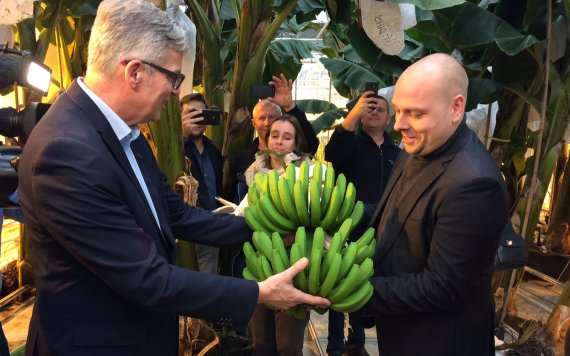Pieter Vink (Boerenhart) is presented with the first Dutch bananas by professor Gert Kema. © Jac Niessen
It started as a joke to do something unique during the anniversary year of the university, explains professor by special appointment of Tropical Phytopathology and banana expert Gert Kema. ‘Let’s try to harvest a home-cultivated banana by Christmas.’ And thus, with the help of Pieter Vink of the regional farmers cooperation Boerenhart, the idea for the Dutch banana was borne.
The Dutch banana is not like other bananas. This banana was grown on substrate. To be precise: on mineral wool and coconut fibres. As far a Kema knows, it was the first time this was attempted. And they managed to do it, as the huge, six-metre-high banana plants filling up the greenhouse can attest. With the press attending on Wednesday, the first bunches were harvested and presented by Kema to Vink of Boerenhart.
Ripening
The presentation is ritual, as the bananas are far from being ripe. They will first need to spend a week in a ripening room at Chiquita, the giant in the banana business and partner in the project. After that, the bananas will be available from Boerenhart’s clients. ‘The restaurants and hospitals in the region are certainly interested’, Vink says. The price of the bananas is unclear for the moment. There are rumours that the bananas might cost up to a euro a piece.
It is about the story behind the fruit.
Pieter Vink (Boerenhart)
According to Vink, it is not that important. ‘It is about the story behind the fruit.’ This story is the scientific side of the Dutch banana. The concept is to outsmart the widely feared Panama disease by growing bananas on substrate. This disease is caused by the soil fungus Fusarium oxysporum. By literally growing the plant above ground on a substrate, the fungus is denied its options.
More sustainable
According to Kema, the experiment in Radix has demonstrated that it is possible. Moreover, cultivation on substrate is much more sustainable, as it does not require pesticides, no nutrients are lost, and the cultivation can be timed perfectly regarding the harvest time. However, it does require a lot of energy, light and space. The greenhouse is heated to a tropical 27 degrees Celsius. And it is actually too small for a banana plant.
Besides being green, the harvested bananas are also somewhat small. According to Kema, this is because the growing conditions were not optimal. The plants are packed close to each other, which caused them to get less light than they needed. Growing pains. A next experiment is already on its way. Not in the Radix greenhouses, but somewhere in a factory hall or large barn. Kema will also be experimenting with this method in the Philippines.

